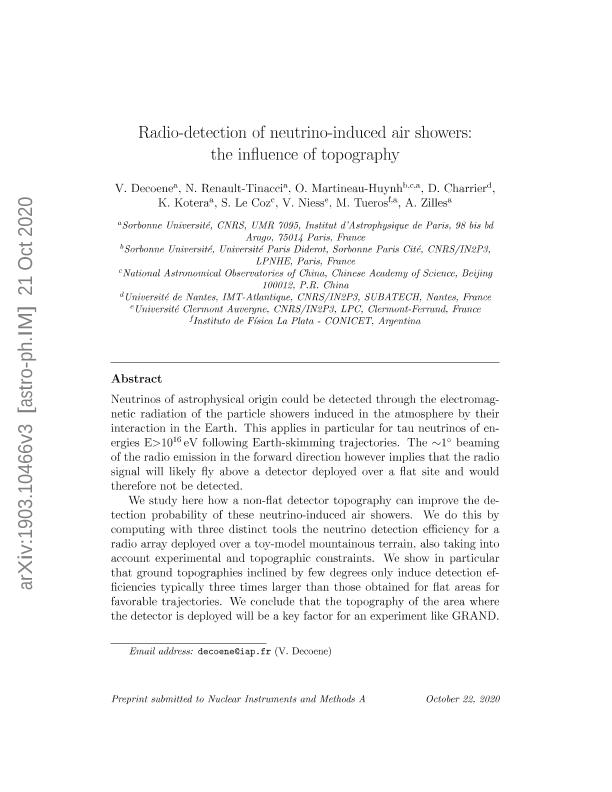Artículo
Radio-detection of neutrino-induced air showers: The influence of topography
Decoene, V.; Renault-Tinacci, N.; Martineau Huynh, O.; Charrier, D.; Kotera, K.; Le Coz, S.; Niess, V.; Tueros, Matias Jorge ; Zilles, A.
; Zilles, A.
 ; Zilles, A.
; Zilles, A.
Fecha de publicación:
01/2021
Editorial:
Elsevier Science
Revista:
Nuclear Instruments and Methods in Physics Research A: Accelerators, Spectrometers, Detectors and Associated Equipament
ISSN:
0168-9002
Idioma:
Inglés
Tipo de recurso:
Artículo publicado
Clasificación temática:
Resumen
Neutrinos of astrophysical origin could be detected through the electromagnetic radiation of the particle showers induced in the atmosphere by their interaction in the Earth. This applies in particular for tau neutrinos of energies E>1016eV following Earth-skimming trajectories. The ∼1° beaming of the radio emission in the forward direction however implies that the radio signal will likely fly above a detector deployed over a flat site and would therefore not be detected. We study here how a non-flat detector topography can improve the detection probability of these neutrino-induced air showers. We do this by computing with three distinct tools the neutrino detection efficiency for a radio array deployed over a toy-model mountainous terrain, also taking into account experimental and topographic constraints. We show in particular that ground topographies inclined by few degrees only induce detection efficiencies typically three times larger than those obtained for flat areas for favorable trajectories. We conclude that the topography of the area where the detector is deployed will be a key factor for an experiment like GRAND.
Archivos asociados
Licencia
Identificadores
Colecciones
Articulos(IFLP)
Articulos de INST.DE FISICA LA PLATA
Articulos de INST.DE FISICA LA PLATA
Citación
Decoene, V.; Renault-Tinacci, N.; Martineau Huynh, O.; Charrier, D.; Kotera, K.; et al.; Radio-detection of neutrino-induced air showers: The influence of topography; Elsevier Science; Nuclear Instruments and Methods in Physics Research A: Accelerators, Spectrometers, Detectors and Associated Equipament; 986; 1-2021; 1-30
Compartir
Altmétricas



